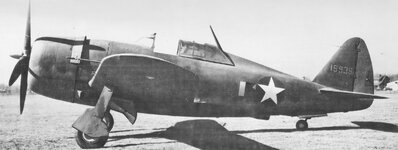Hi!
I´m trying to collect data to convert a 1/72 P-47D to P-47B to XP-47F.
A web search shows two drawings:

and:

As you can see, there are substantial differences between the two drawings regarding wing planform and skin panels. Do you know which one is correct?
Lower one came from a russian site and has a longer chord in the wing root. Flaps and ailerons are substantially bigger, also.
I´m trying to collect data to convert a 1/72 P-47D to P-47B to XP-47F.
A web search shows two drawings:
and:
As you can see, there are substantial differences between the two drawings regarding wing planform and skin panels. Do you know which one is correct?
Lower one came from a russian site and has a longer chord in the wing root. Flaps and ailerons are substantially bigger, also.

